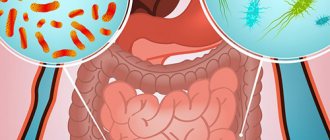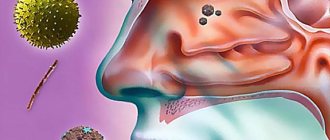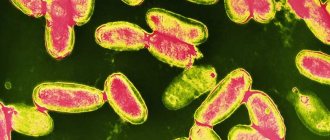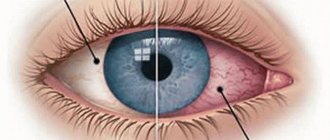Failure to comply with food preparation technology and hygiene rules can cause severe infectious diseases of the digestive system. Salmonellosis in children is often severe and life-threatening.
The onset of the disease is acute. Body temperature rises, frequent vomiting, severe toxicosis, upset stool, and bloated stomach are possible. These are typical signs of salmonella infection in the body.
Treatment of salmonellosis in infants is most often carried out in a hospital. During the illness, dehydration of the body is observed, the function of the circulatory system is disrupted, and the liver increases in size.
Salmonella bacteria are highly resistant to antibiotics, so their choice is limited. You cannot self-medicate and if you suspect salmonellosis, you must take your child to the clinic to confirm or refute the diagnosis.
With timely and correct treatment, recovery occurs. You can learn more about the disease and expected treatment by reading the article to the end.
Causes of salmonellosis. Main routes of infection
- Food is the most common route of infection, the cause of which is insufficient heat treatment, violation of sanitary and epidemiological standards for storage and transportation of products, and failure to comply with personal hygiene rules.
- Contact and household. Children become infected with salmonellosis through contact with a sick person or with people caring for animals that are infected or are carriers of the infection. Bacteria can persist for a long time on toys, clothing, towels and other items that a sick person has come into contact with. This route of infection is the main one for infants.
- Transplacental - from mother to fetus.
You can become infected with salmonellosis even where you did not expect it at all: for example, by eating a cream cake in a cafe where there is poor sanitary control over the production and quality of products. In some products (milk, meat products), salmonella can not only survive, but also multiply. Salting and smoking have a very weak effect on them, and freezing even increases the survival time of microorganisms in products. Almost all animals are infected with salmonella to one degree or another, many of them are healthy carriers. Among birds, chicken is the leader in the likelihood that an absolutely healthy bird is a carrier of salmonellosis. Today this is one of the leading ways of spreading this disease.
The unique ability of the bacterium is that when food is contaminated, it does not in any way change its color, smell or taste. Any product where salmonella can potentially multiply is a danger to the child.
Photo source: shutterstock.com
No one is immune from salmonellosis infection. There are two ways to avoid illness: not eating foods or processing them thermally.
The child’s body is very vulnerable to various infectious diseases under the influence of negative factors. After all, in childhood, intestinal immunity only develops and still weakly protects the baby. Therefore, to prevent the disease, doctors do not recommend that children under 5 years of age have contact with pets and eat raw animal products.
Preventing Salmonella Infection
For preventive purposes, follow-up actions must be taken:
- It is necessary to stop the sources of infection.
- Use products that have undergone thorough heat treatment.
- Support immunity.
- Follow all hygiene rules.
To prevent the formation of an epidemic of salmonellosis, it is recommended to vaccinate all farm livestock and poultry.
Salmonella enteritidis is considered a very dangerous microorganism that affects the digestive organs. This bacterium is the causative agent of a serious disease that carries with it negative and dangerous consequences. If you detect the slightest signs of infection, you should immediately consult a doctor for help.
https://youtu.be/u6Ny3s4qnuA
Infectious diseases L.N. Milyutina, A.V. Gorelov Central Research Institute of Epidemiology, Ministry of Health of the Russian Federation
Among infectious diseases of childhood, the most common after acute respiratory viral diseases are acute intestinal infections (AEI) (see table). The range of pathogens that cause acute intestinal infections increases every year due to new bacteria and viruses, but the group of pathogenic microorganisms, united under the name Salmonella (named after the American researcher D.E. Salmon who first described them), has continued to retain one of the leading places in the last 20 years. – both throughout the world and in our country. Salmonella causes gastrointestinal diseases in animals, birds, and fish. People, including very young children, including newborns, are also susceptible to salmonellosis. Salmonella often causes epidemic outbreaks (in families, closed groups), and in case of untimely and improper treatment, even death.
Symptoms of childhood salmonellosis:
- acute onset;
- rumbling in the stomach;
- severe pain in the navel area;
- nausea;
- vomiting, sometimes with the presence of mucus and bile;
- diarrhea;
- a sharp increase in temperature;
- lethargy, weakness;
- the tongue is covered with a characteristic coating, and an unpleasant odor comes from the mouth.
Children under two years of age are most susceptible to infection, since they put dirty hands and various objects in their mouths when teething, and hygiene skills at this age are still poorly developed.
https://youtu.be/QiLSpa2Myyg
Gastrointestinal form
This type of disease is considered the most common. On average, the duration of treatment for the gastrointestinal form is 2 weeks.
Main manifestations of the disease:
- heat;
- headache and general weakness;
- the appearance of a white coating on the tongue;
- the appearance of pain in the abdomen;
- dizziness;
- vomiting, bile and undigested food appear in the vomit;
- stool takes on a greenish tint;
- diarrhea with mucous discharge.
In addition, the infected person may experience low blood pressure, tachycardia and convulsions.
Symptoms of salmonellosis in children under one year of age:
- lethargy, loud and sharp sounds cause anxiety in the baby;
- refusal to eat;
- frequent bowel movements;
- on the 3rd day of illness the temperature rises;
- the stool becomes liquid, watery, and green in color;
- A dry mouth and extreme thirst are a symptom of the onset of dehydration.
Salmonellosis in children under one year of age can last several weeks or even months. After the illness, the baby may have abdominal pain, irregular bowel movements, and increased allergies for 2 months.
Salmonellosis in children 2 years of age and older occurs in the form of gastritis and gastroenteritis.
Asymptomatic form
In this situation, the disease occurs in a hidden latent form. Therapy is not carried out, since the body itself fights the bacteria that have penetrated inside.
If you experience the slightest manifestation of any form of salmonellosis, you should immediately consult a doctor. After all, untimely or improper treatment of this disease can provoke the development of such dangerous pathologies as pneumonia, heart or liver failure, cerebral edema and gastrointestinal diseases.
Treatment of salmonellosis in children
The first signs of salmonellosis are a reason for the mother to call an ambulance. Treatment of childhood salmonellosis involves preventing parents from becoming dehydrated. Any child's first aid kit should always include oral rehydration products. It is important to give the child a sufficient amount of liquid - this can be water, compote, or fruit juice.
Photo source: shutterstock.com
How does an intestinal infection develop?
It can take several hours or up to 4 days from the time of infection to the onset of symptoms. During this time, pathogenic microorganisms are inactivated under the influence of gastric juice or cellular immunity. When they die, they release endotoxins. It is because of them that symptoms of intoxication arise.
If the state of immunity is unsatisfactory, bacteria penetrate the epithelial cells of the gastrointestinal tract, where they begin to multiply. Inflammation develops at the site of penetration. Perforation of inflamed tissues and, as a consequence, the spread of bacteria and the development of generalized forms of the disease cannot be ruled out.
In the process of fighting the pathogen, the immune system produces antibodies to the toxins and antigens of the bacterium. The infectious load and symptoms of intoxication weaken, but the pathogen remains in the intestines. It is excreted for 2-3 months along with feces. This is a condition for the implementation of the fecal-oral route of infection of people who are in contact with the ill person.
With salmonellosis, a specific unstable immunity to a specific serotype of the pathogen is formed. The body remains unprotected against other types of salmonella. Antibodies remain in the blood for 5-6 months. Re-infection may then occur.
Key points during treatment:
- oral rehydration with prepared saline solutions;
- actively feeding the child: if the child refuses to drink, it is necessary to feed him with a teaspoon or from a syringe every 5 minutes;
- the first day - fasting, then - a special diet;
- preparations containing probiotics;
- antipyretics at high temperatures;
- Bed rest is indicated for mild cases of the disease for 1 week, for severe cases - up to 3 weeks.
The basis for hospitalization is the severity of the child’s condition. In mild cases of the disease, salmonellosis is treated at home. With strict control over the amount of fluid you drink and following a diet, the disease usually goes away on its own.
Quite often, mothers and fathers mistake the symptoms of salmonellosis in 6-year-old children for banal poisoning. Therefore, it makes sense to get tested for salmonellosis even when treating at home. This will allow you to accurately find the cause of the disease and make the correct diagnosis.
It has been scientifically proven that taking antibiotics for salmonellosis prolongs the course of the disease. Today, there are international recommendations for the use of antibiotics in the treatment of salmonellosis. They are needed for children with weakened immune systems, children under 2 months of age and when salmonella penetrates beyond the intestines.
40% of all salmonella are multidrug-resistant bacteria, which means they are practically unaffected by antibiotics. Scientists around the world urge not to treat salmonellosis with only intestinal manifestations with antibiotics. Nevertheless, our country’s protocol provides for treatment of children of any age and with any severity of the disease with antibiotics for salmonellosis.
Diagnosis of the disease
To select the appropriate medications, it is important to conduct a thorough diagnosis. The sooner parents contact specialists, the sooner quality first aid will be provided.
Using the symptoms that appear, you can make a presumptive diagnosis. To confirm it, the following methods are used:
- bacteriological culture of stool;
- examination of vomit;
- Analysis of urine;
- blood test for salmonellosis.
Accurate data can be obtained by inoculating biomaterials on a nutrient medium. However, such an analysis takes time - about 10 days. And when treating children, sometimes this is unacceptable.
A blood test is done to determine the effectiveness of the therapy used. First, immediately after infection, and then after 10 days. The data obtained are compared and, if necessary, the selected therapy is adjusted.
Consequences and threats to child health
Why is salmonellosis dangerous in children? This is the first question that arises for parents whose baby is faced with this disease. As a rule, if you consult a doctor in a timely manner, the disease does not cause any complications. However, if a baby whose immunity is not strong enough (for example, an infant) encounters it, or the treatment was not prompt enough, the consequences can be serious.
We have already mentioned that the course of the disease is accompanied by vomiting, diarrhea and other unpleasant symptoms. However, even after recovery, the child faces a number of complications.
- Prolonged dehydration leads to interruptions in the functioning of the renal canals (renal failure) and contributes to the accumulation of nitrogenous waste in the patient’s blood.
- Bacterial excretion that lasts more than 3 months after recovery is a clear sign that the disease has had too strong an effect on the body, and the child now requires treatment for chronic salmonellosis.
- Prolonged intoxication negatively affects the functioning of the cardiovascular system. In particularly advanced cases, it causes cerebral edema.
- The consequences of salmonellosis can also be expressed in inflammation of various internal organs, since salmonella spreads throughout the body through the bloodstream.
- In young patients suffering from chronic diseases, relapses caused by immunodeficiency are common.
However, we should not forget that in addition to these, the disease also has social consequences.
For example, if there is a suspicion that a child is a bacteria carrier, entry into public places is closed to him. And if in the case of an amusement park or swimming pool this does not cause any particular harm, then a ban on visiting a school or kindergarten may cause a lag in the program and a prejudiced attitude.










